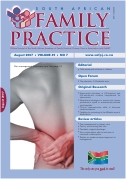The Placenta: A Cinderella Story
Keywords:
placenta, litigation
Abstract
Introduction The placenta is rarely sent for histopathological examination, despite its availability after delivery and the valuable contribution it may make to understanding adverse pregnancy outcome.This may be due to reluctance on the part of surgical pathologists to examine the placenta, due to a number of reasons that are applicable globally, amongst which are limited exposure to placentas during their training and the very different terminology applicable to the pathology of this organ. Why should placenta be examined by a pathologist? Globally there are 4 million neonatal deaths and another 4 million stillbirths annually, and the overwhelming majority occurs in low- and middle-income countries. In South Africa there is limited data available through the Perinatal Problem Identification Programme (PPIP). The data from 2000-2002 showed the commonest primary obstetric cause of perinatal death to be unknown. Contribution of placental pathology Histopathological examination of the placenta may provide information that may not be determined clinically. There is poor correlation between maternal indicators of infection and placental findings, and many placental causes of fetal and perinatal death may be clinically silent. Placental examination is vital to the determination and timing of intrauterine events that may result in adverse pregnancy outcome and in doing so may assist in the medico-legal assessment of cases. Cerebral Palsy (CP) was until fairly recently attributed to intrapartum hypoxia, with liability borne by the clinicians and delivery units. Studies where the placenta was submitted for histopathology have shown that in less than 10% of cases of CP was intrapartum hypoxia the possible cause of brain damage. It is now widely accepted that multiple early and recent insults act together to increase the risk of brain injury at birth, and many of these can be identified by histopathological examination of the placenta. Conclusion The contribution that the placenta may make to the understanding of the cause and timing of events resulting in adverse pregnancy outcome, as well as the management of the neonate, the mother and future pregnancies is being recognized by obstetricians, neonatologists, pathologists and administrators of health care institutions and medical insurance companies
Published
2007-08-02
Section
Forum
By submitting manuscripts to SAFP, authors of original articles are assigning copyright to the South African Academy of Family Physicians. Copyright of review articles are assigned to the Publisher, Medpharm Publications (Pty) Ltd, unless otherwise specified. Authors may use their own work after publication without written permission, provided they acknowledge the original source. Individuals and academic institutions may freely copy and distribute articles published in SAFP for educational and research purposes without obtaining permission.

